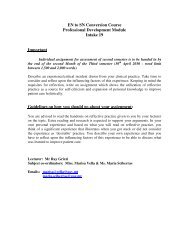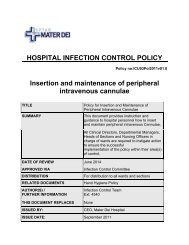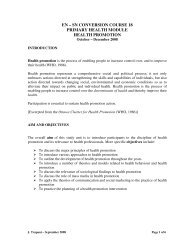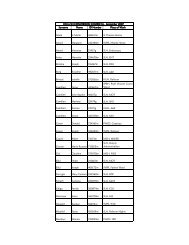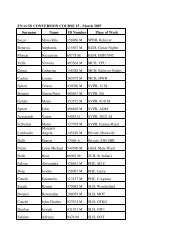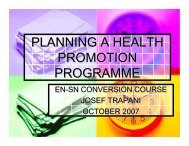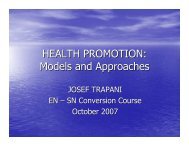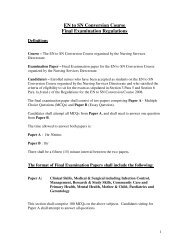IV Pump assessment
IV Pump assessment
IV Pump assessment
Create successful ePaper yourself
Turn your PDF publications into a flip-book with our unique Google optimized e-Paper software.
Department Nursing Services’ Standards<br />
Assessment Checklist for I.V. <strong>Pump</strong>s<br />
Criteria 1: Hand washing / Hand rub as required.<br />
Students need to perform the six steps of aseptic hand washing with soap and water. If their<br />
hands are clinically clean they can use alcohol based gel as long as they follow the six steps of<br />
hand hygiene.<br />
[F] Criteria 2: Checked patient’s name with wrist tag and treatment chart.<br />
[F] Criteria 3: Enquired for any allergies associated with drug.<br />
In criteria 2 and 3, students are expected to check with the treatment chart, or patient’s notes,<br />
or patient (if conscious), and patient’s ID tag.<br />
[F]Criteria 4: Checked drug with treatment chart.<br />
Students need to demonstrate knowledge of the five ‘rights’.<br />
[F] (i) Check the dose prepared with treatment chart.<br />
(ii) Counter check of drug name and dose prepared with<br />
treatment chart<br />
[F] (iii) Check the drug/s and disposal equipment for expiry<br />
dates and signs of contamination<br />
Criteria 5: Counter checked patient’s identity with treatment chart .<br />
Students are allowed to double check with assessor (in simulation tests) and with qualified<br />
nurses (in the clinical environment) or at least demonstrate knowledge of such criteria.<br />
Criteria 6: Demonstrates an awareness of the importance of knowledge of drugs<br />
in/compatibility.<br />
Students should demonstrate that they know where to check for such criteria – BNF/drug<br />
insert/Pharmacy.<br />
Criteria 7: States at least one side effect from the particular drug to the given<br />
scenario whereby student is allowed to check with BNF<br />
[Literature/Pharmacy].<br />
1
Students should explain such effects and if they have no knowledge about the drug, they<br />
should refer to the available information (BNF etc<br />
[F] Criteria 8: Medication mixed & diluted accurately:<br />
In the case of an ampoule with drug already in solution:<br />
Final solution: _____ mg / _____ml.<br />
Students are expected to draw the exact volume according to the concentration indicated on the<br />
ampoule.<br />
Eg.: Scenario requires students to prepare Dopamine 200mg in a total of 50ml 5% Dextrose<br />
and the ampoule states 40mg/ml. Students need to draw exactly 5ml to make up exactly 200mg<br />
of dopamine. This should be drawn up in a separate 5ml syringe. Next the student is expected<br />
to fill a 50ml syringe with 5% Dextrose (using the aseptic technique as per criteria No. 9) up to<br />
the 45ml mark and then the student injects the drug from the 5 ml syringe into the 50ml syringe<br />
to make up the exact solution.<br />
In the case of a vial with drug in powder state:<br />
Students need to reconstitute the drug with the recommended volume and withdraw according<br />
to the dose required.<br />
Eg.: Scenario requires students to reconstitute a Dobutamine 250mg vial with 15ml sterile<br />
distilled water and need to mix it with 5% Dextrose up to the 50ml mark of the 50cc syringe.<br />
To prepare the full dose, students need to withdraw all the contents of the vial irrespective<br />
whether the final volume is less than 15ml (if there was a contraction) or more than 15ml (if<br />
there was an expansion), in a separate 20ml syringe. Next the student is expected to fill a 50ml<br />
syringe with 5% Dextrose (using the aseptic technique as per criteria No. 9) up to the mark<br />
where it will make a total of 50ml when the students inject the drug from the 20ml syringe to<br />
the 50ml syringe. Hence if, for example, the final volume in the 20ml syringe was 17ml (due to<br />
expansion), students are expected to fill the 50ml syringe up to the 33ml mark with the 5%<br />
dextrose so that when the drug is injected in the 50ml syringe, the total volume will be exactly<br />
50ml (17ml + 33ml) as required in the scenario.<br />
2
[F] Criteria 9: Aseptic technique followed while preparing the drug.<br />
This criteria is considered a crucial one in the sense that if any contamination of equipment<br />
during the process of preparation and administration of the drug is observed, students get a<br />
straight fail.<br />
N.B. If the scenario necessitates students preparing the drug in the treatment room, it can be<br />
done this way as long as the prepared drug is sufficiently covered and protected until it<br />
reaches the patient. In such case students need to get verbal consent and check the<br />
cannula prior the preparation of the actual drug.<br />
Needle Recapping<br />
Infection control policy stipulates that under no circumstances should needle recapping be<br />
practiced. However this addresses mainly used (contaminated) needles. In the case of <strong>IV</strong> drug<br />
preparations, since the needle is still sterile, safe recapping is allowed as long as students do<br />
not contaminate the needle.<br />
If the needle is then used on the patient, it definitely should not be recapped but disposed of in<br />
the sharps container.<br />
[F] Criteria 10: Correctly labels solution additive.<br />
Students should be observed preparing the additive label and fill in the necessary details as<br />
indicated on the label itself. It is important that the label is endorsed by both preparer and<br />
checker. In simulated tests students are at least expected to demonstrate such knowledge.<br />
However in the clinical environment students need the signatures of two qualified nurses.<br />
Criteria 11: Communication.<br />
Students need to demonstrate effective communication through informed consent. The<br />
following are the criteria on which students will be assessed:<br />
(i) Introducing self<br />
(ii) Explaining procedure<br />
(iii) Providing clear instructions<br />
(iv) Making use of non-verbals<br />
3
[F] Criteria 12: Prepares <strong>IV</strong> tubing maintaining sterility of connecting points.<br />
In the case of syringe pump drivers:<br />
Students are expected to correctly prepare the <strong>IV</strong> extension tube maintaining full sterility while<br />
purging the air out of the tube and while attaching the female end of the tube to the nozzle of<br />
the syringe.<br />
In the case of volumetric pumps:<br />
Students are expected to correctly prepare the dedicated <strong>IV</strong> tubing set maintaining full sterility<br />
while piercing the spike in the solution bag and while attaching the set to the end of the <strong>IV</strong><br />
cannula or 3-way tap.<br />
Criteria 13: Correctly loads the syringe or the <strong>IV</strong> tubing on the syringe pump driver or<br />
the volumetric pump and attaches it to the appropriate port.<br />
Criteria 14: I.V. cannula checked for patency and any signs of phlebitis,<br />
infiltrations, and/or swelling around the cannula.<br />
Students should be observed doing so and also asking patients if they are experiencing any pain<br />
on and around the cannula insertion site. Checking for patency can be done by injecting a<br />
small amount of flush solution (preferably 5ml to 10ml N/Saline or distilled water) prior to<br />
connecting the extension tube or <strong>IV</strong>I set to the cannula port while observing if patient is<br />
complaining or demonstrating any signs of pain or whether the flush being injected is<br />
infiltrating into the surrounding tissues.<br />
In the case that an <strong>IV</strong> cannula has already attached with it an <strong>IV</strong> infusion pump (syringe or<br />
volumetric) and the scenario prompts students to just change the syringe or infusion bag but<br />
not the connecting tube or <strong>IV</strong> set, then there is no need for students to check for patency of the<br />
cannula by flushing it, but they still are expected to observe the site for any signs of phlebitis,<br />
infiltrations, and/or swelling around the cannula.<br />
[F] Criteria 15: Correctly sets the pump according to the scenario, (i.e. hourly rate<br />
in both type of pumps and ‘Volume to be infused’ in the case of<br />
volumetric pumps).<br />
4
[F] Criteria 16: Correctly documents the drug given.<br />
(i) Counter signature requested for documentation<br />
Students are expected to document the drug on the prescription sheet accurately, that is, enter<br />
the date (if necessary) and sign in the space against the time of the drug was due. Students need<br />
to demonstrate that a counter signature is necessary by the person who double checked with<br />
them.<br />
Criteria 17: Indicates the need to monitor the patient for the drug’s effect / side<br />
effect / reaction according to the given scenario.<br />
Students are expected to give a rationale why they need to stay near the patient for a while<br />
especially if they suspect that the patient is having a reaction. They should at least know the<br />
cardinal signs and symptoms of anaphylactic shock or reaction and what action to take.<br />
Criteria 18: All injecting materials disposed off correctly according to infection<br />
control policies.<br />
Students are expected to know what should be disposed in the different containers and should<br />
be awarded marks according to the following criteria:<br />
In the sharps container: Needles and sharp glass ampoules.<br />
In the domestic bag: Plastic syringes, rubber capped glass vials, syringe wrappers,<br />
needle caps, and alcohol swabs.<br />
P.S.: Even if a syringe is lightly soiled with blood, it still should be disposed of in the<br />
domestic bag.<br />
Pass mark: 75% or better<br />
[F] = Failing Point<br />
N.B. Criteria preceded with an ‘[F]’ indicate that if students fail any one of such criteria they<br />
get a straight ‘FAIL’ irrespective of the final mark they achieve.<br />
5



